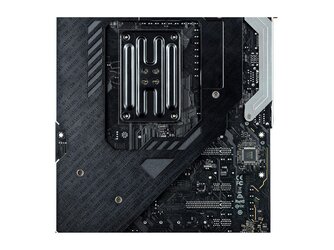- Joined
- Oct 2, 2003
What is the deal with the misleading PCIe slot information on data sheets? It is extraordinarily tedious to have to look at manuals to figure out what the slots are actually running at.
I am looking for a motherboard that has a 1 PCIe 4.0 or 5.0 x 16 slot for a graphics card AND a 3.0 x 4 slot for 10gbe nic. PCIe3.0+ (or higher) x8 slot would be better for other peripheral ideas i have in mind but they seem non existent with current boards.
Examples:
MSI
MSI z690-A
SPECSHEET says 3 PCI-E x 16 and 1 PCI-E x 1
MANUAL says PCIe 5.0 x 16, PCIe 3.0 x 4, PCIe 3.0 x 1, and another PCIe 3.0 x 1 -- What the heck is that, certainly not 3 x16 slots.
Asrock
Asrock z690 Steel Legend
SPECSHEET says 1 PCIe 5.0 x16, 1 PCIe 4.0 x16, 1 PCIe 3.0 x16, 2 PCIe 3.0 x1
MANUAL says (PCIE2/PCIE3/PCIE5: single at Gen5x16 (PCIE2); dual at Gen5x16 (PCIE2) / Gen4x4 (PCIE3); triple at Gen5x16 (PCIE2) / Gen4x4 (PCIE3) / Gen3x4 (PCIE5))* * Supports NVMe SSD as boot disks 2 x PCIe 3.0 x1 Slots ---How many x16 slots is that? 1 max.
Asus
Asus Z690-P D4
SPECSHEET says 1 x PCIe 5.0 x 16, 1 PCIe 4.0 x 16, 2x PCI3 3.0x16, 1xPCIe 3.0x1
MANUAL says 1 x PCIe 5.0/4.0/3.0 (!) x 16, 1 x PCIe 4.0/3.0 x4, 2 PCIe 3.0 x 4, 1 PCIe 3.0 x 1
I get that those are the slots and indicate what kind of PCIe card would FIT in the slot, but it is completely useless and makes the shopping process so tedious I can't even stand it. Is there a DB somewhere with current motherboards and actual PCIe performance specs?
/rant
I am looking for a motherboard that has a 1 PCIe 4.0 or 5.0 x 16 slot for a graphics card AND a 3.0 x 4 slot for 10gbe nic. PCIe3.0+ (or higher) x8 slot would be better for other peripheral ideas i have in mind but they seem non existent with current boards.
Examples:
MSI
MSI z690-A
SPECSHEET says 3 PCI-E x 16 and 1 PCI-E x 1
MANUAL says PCIe 5.0 x 16, PCIe 3.0 x 4, PCIe 3.0 x 1, and another PCIe 3.0 x 1 -- What the heck is that, certainly not 3 x16 slots.
Asrock
Asrock z690 Steel Legend
SPECSHEET says 1 PCIe 5.0 x16, 1 PCIe 4.0 x16, 1 PCIe 3.0 x16, 2 PCIe 3.0 x1
MANUAL says (PCIE2/PCIE3/PCIE5: single at Gen5x16 (PCIE2); dual at Gen5x16 (PCIE2) / Gen4x4 (PCIE3); triple at Gen5x16 (PCIE2) / Gen4x4 (PCIE3) / Gen3x4 (PCIE5))* * Supports NVMe SSD as boot disks 2 x PCIe 3.0 x1 Slots ---How many x16 slots is that? 1 max.
Asus
Asus Z690-P D4
SPECSHEET says 1 x PCIe 5.0 x 16, 1 PCIe 4.0 x 16, 2x PCI3 3.0x16, 1xPCIe 3.0x1
MANUAL says 1 x PCIe 5.0/4.0/3.0 (!) x 16, 1 x PCIe 4.0/3.0 x4, 2 PCIe 3.0 x 4, 1 PCIe 3.0 x 1
I get that those are the slots and indicate what kind of PCIe card would FIT in the slot, but it is completely useless and makes the shopping process so tedious I can't even stand it. Is there a DB somewhere with current motherboards and actual PCIe performance specs?
/rant

